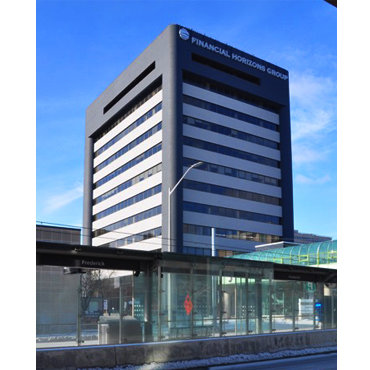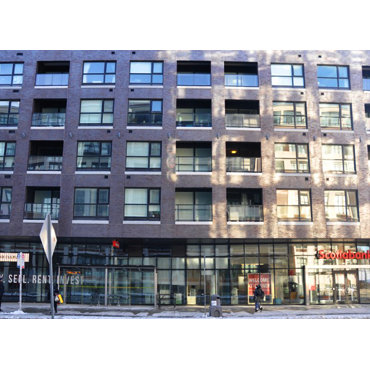What's with all the black and dark grey building exteriors lately? New construction; building renos; paint jobs to existing brick buildings; it seems to be the flavour (or colour) of the month. The Oxlea Tower on Frederick St., for example, now hulks even more on Kitchener's skyline, courtesy of its Darth Vader colour scheme. Black and grey come in all sorts of materials: as siding, baked coatings, panels, back-painted glass, and even masonry. Black is showing up in homes, office & residential towers, commercial buildings and public institutional facilities.
Are these a symptom of our times, something dour and lifeless that we're living through? Or perhaps emblematic? Will we look back at them and say, “Oh yeah, second decade!”?

Why such predilection on the part of designers and owners? Many and varied reasons come to mind, first among them being that grey and black might be considered “safe” choices, or even a non-choice, avoiding actually “choosing” a colour. Is it that black is “minimal” “clean” or “cool”? Are we using black to communicate ideas of power and authority? Is there some association with the urban environments of literature, graphic novels, or comic books, depicted as a place where evil things happen, full of dark shadows and forces?
For the longest time white buildings were considered modern, often designed by people dressed in black. Perhaps the simplicity, asceticism, and “matches everything” of dressing that way has slipped off the shoulder and onto the buildings they design. We just don't know.

We think it's time to carefully consider the implications of this widespread and indiscriminate use of black, and very dark colours in general, in the environment through which we move, and as the backdrop for our lives. There are many reasons to reconsider the choice:
- Just like the ubiquitous asphalt of our streets, dark colours on buildings absorb more summer heat. In the evenings, when it starts to cool off, we can feel that heat being released from the building. Standing next to a black facade at sundown, or in the midst of newly asphalted roadway after a hot day, and you'll feel it. It worries us that dark colours contribute to the increased temperature in urban areas, or what we call the “heat island effect”.
- Dark colours absorb more light, trapping it rather than offering it for further use. We expend energy and financial resources trying to illuminate our streets at night, and dark building facades work against this. Brighter buildings and warmer, more human tones can contribute to the nighttime urban scene by giving the light back on to the street and into our lives, often with colours that make a positive contribution to the scene. Dark buildings can't do that, and our streets are less vibrant, less alive, as a result.
- Architectural details on buildings depend on shadows and contrasts to be seen. That's how the eye works! We see by contrast. Elements that protrude and recede contribute to the form, the rhythm and texture, giving interest and detail to a facade. When the sun is shining it is truly delightful to see this level of detail, and very necessary to having human scale in our environment. Sadly, when the facade is black, or very dark, the shadows are lost. Default to black means a decision to take away that potential for delight, for detail and scale, through the choice of colour and lighter tones.
- And, finally, colour has consequence. It works to subtly affect our mood and state of mind. We soak in our environment unconsciously, and the dark does very little to brighten our day. Although it has traditional associations with elegance and sophistication in our dress, that feeling might not translate so well in dressing a building. At the scale of our community the dark building has darker associations that we think come to the fore: looming rather than delighting, projecting distance and power rather than warmth and invitation, and setting aside the possibility of colour with accent in favour of uniformity.
How do you feel about this rapid proliferation of black in the buildings of our cities? We would like to hear from you!




